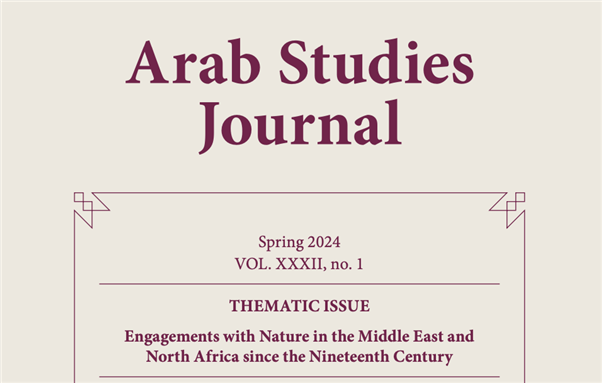[This is the Editor's Note and Table of Context for the Arab Studies Journal Spring 2024 issue, which is now available for purchase. Click here to subscribe to Arab Studies Journal.]
ARAB STUDIES JOURNAL
VOL. XXXII, NO. 1
Editors’ Note
We are proud to publish this special issue as an intervention into the urgent and ongoing multidisciplinary conversation on questions of nature in the Middle East. Coordinated by guest editors Katharina Lange and Juliane Schumacher, the issue significantly expands this conversation’s regional and thematic focuses. Florian Zemmin introduces Islamic modernist conceptions of nature as an integral part of the history of global environmental thought. His article explores how Rashid Rida (1865–1935) and his intellectual circle constructed an environmental ethics within the normative matrix of the shari‘a. Thomas Kuehn calls our attention to the little-studied Province of Yemen as a critical site for the development of Ottoman environmental management. Military and technical struggles to dominate Yemeni nature were foundational to late-nineteenth- and early-twentieth-century Ottoman governance in the province, and ultimately made possible the post-Ottoman Yemeni state. Emily O’Dell further expands our geographic focus to the equally understudied context of Oman. Her article explores how modern Omani poets have employed natural imagery and evocations of landscape as a means to negotiate their experience of repression and exile. Finally, Katharina Lenner and Sylvie Janssens contribute a powerful interdisciplinary interrogation of the development of environmental conservation practices in Jordan. Their analysis reveals how local and international NGOs advanced competing and intersecting conceptions of conservation, and how Jordanian communities have negotiated, resisted, and/or profited from related interventions. Separate from this special issue, our reviews section features insightful perspectives on major recent works in Ottoman and post-Ottoman history.
Underscoring the urgency of the kind of inquiry proposed by this special issue is the present grave escalation of warfare against the capacity of land to sustain human and nonhuman life. For nearly a year, Israeli artillery has rained thousands of white phosphorous munitions—among a barrage of others—into the Gaza Strip and South Lebanon, leaving excruciating chemical burns across human flesh and agricultural fields. After burning down tree groves and planted crops, these munitions’ residues have seeped into water supplies and pervaded the air, poisoning people, plants, and animals. The long-term effects of these munitions remain unknown, a degree of terrible uncertainty recalling that which surrounded the United States’ 1991 use of depleted uranium munitions against Iraqi forces and civilians. White phosphorous bombardments constitute an escalation of what the multidisciplinary research group Forensic Architecture term “herbicidal warfare” against Gaza, which the Israeli military has prosecuted since 2014. Bulldozers have razed fields and orchards, bombs have shattered greenhouses, and soldiers have demolished and obstructed supplies of food and water. Each of these are implements in an Israeli military strategy of ecocide, which seeks to destroy the natural, social, and technological infrastructure that sustains life in Gaza. These cataclysmic attacks on people and nature are part of Israel’s genocidal war on Palestinians in the Gaza Strip and annihilationist policy vis-à-vis Lebanon’s southern border region. They demand from us focused analysis of the environment not as an object for boutique politics, but as the central terrain of struggle for the future.
Table of Contents
EDITORS’ NOTE
ARTICLES
SPECIAL SECTION: ENGAGEMENTS WITH NATURE IN THE MIDDLE EAST AND NORTH AFRICA SINCE THE NINETEENTH CENTURY
"Section Introduction: Appropriations, Representations, Productions: Engagements with “Nature” in the Middle East and North Africa Since the Ninteenth Century"
Katharina Lange and Juliane Schumacher
"What is Islamic About Islamic Conceptions of Nature?: Rashid Rida’s Formative Contributions in the First Volumes of Al-Manar"
Florian Zemmin
"Managing the Hazards of Yemen’s Nature: Military Violence, Governance, and the Environment in Ottoman Southwest Arabia, 1872–1914"
Thomas Kuehn
"Nature Imagery in Modern Omani Poetry: Alternative Eco-Productions of Sociality, Individuality, and Immateriality"
Emily Jane O’Dell
“'Conserve Not Protect'?: Competing Environmental Imaginaries in Jordan’s Conservation Thinking and Practice"
Katharina Lenner and Sylvie Janssens
REVIEWS
Dangerous Gifts: Imperialism, Security, and Civil Wars in the Levant, 1798–1864
By Ozan Ozavci
Reviewed by Zoe Griffith
The Unsettled Plain: An Environmental History of the Late Ottoman Frontier
By Chris Gratien
Reviewed by Atar David
Losing Istanbul: Arab-Ottoman Imperialists and the End of Empire
By Mostafa Minawi
Reviewed by Edhem Eldem
Bedouin Bureaucrats: Mobility and Property in the Ottoman Empire
By Nora Elizabeth Barakat
Reviewed by Lâle Can

















